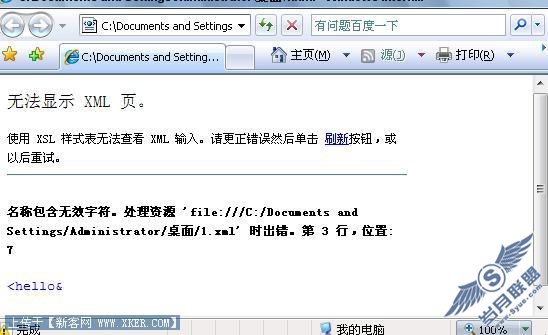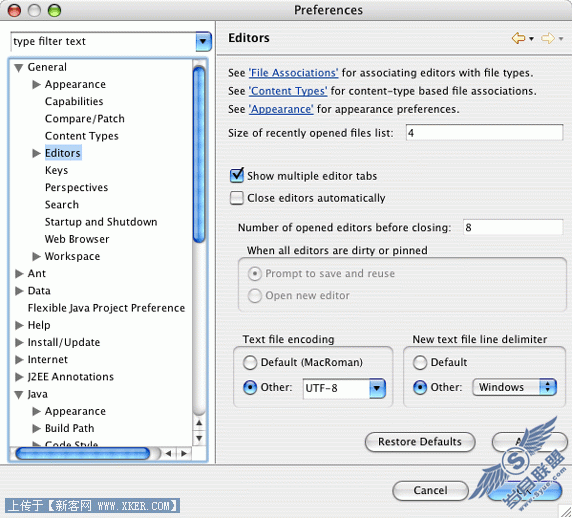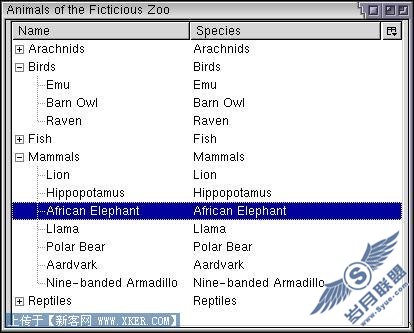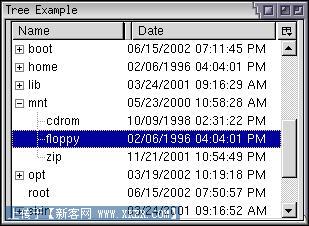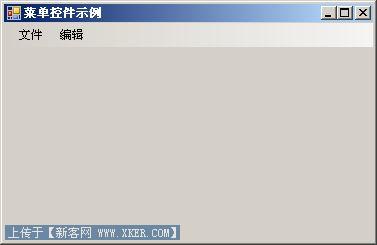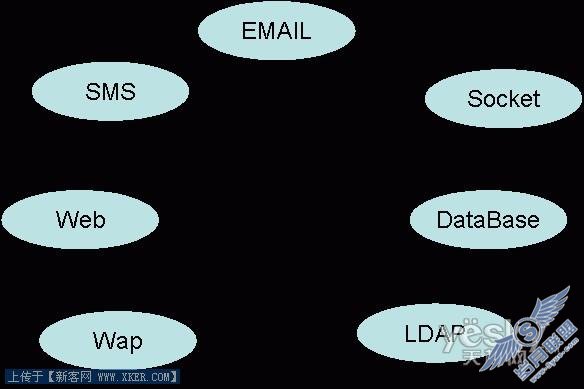用SAX和XNI检测XML文档的编码
XML 根据 Unicode 字符进行定义。在现代计算机的传输和存储过程中,那些 Unicode 字符必须按字节存储,通过解析器进行解码。很多编码方案可实现此目的:UTF-8、 UTF-16、ISO-8859-1、Cp1252 和 SJIS 等。
通常情况下,但不一定总是这样,您实际上不关注基本编码。XML 解析器对任何写入到 Unicode 字符串和字符数组中的文档进行转换。程序对解码后的字符串进行操作。本文讨论真正关注基本编码的 “不常出现” 的情况。
最常见的情况是想为输出结果保存输入编码。
另外一种情况是,不用解析文档,而将其作为字符串或字符大对象(Character Large Object, CLOB)存储在数据库中。
类似地,有些系统通过 HTTP 传输 XML 文档时,并没有全部读取文档,但需要设置 HTTP 的 Content-type 报头,指定正确的编码。在这种情况下,您需要知道文档是如何编码的。
大多数情况下,对于您编写的文档,您知道如何编码。但是,如果不是您编写的文档 — 只是从其他地方接收的文档(例如,从一个 Atom 提要中)— 那么最好的方法是使用一个 streaming API,例如 Simple API for XML(SAX)、Streaming API for XML(StAX)、System.Xml.XmlReader 或 Xerces Native Interface(XNI)。另外,也可以使用树型 API,例如文档对象模型(Document Object Model,DOM)。但是,它们需要读取整个文档,即使通常只需读取前 100 个字节(或更少)来判断编码。streaming API 可以只读取需要的内容,一旦得到结果后,就不再解析。这样就会更有效率。
SAX
目前,大多数 SAX 解析器,包括与 Sun 公司的 Java™ 软件开发套件(JDK)6 绑定的 SAX 解析器,可以用来检测编码。该技术不难实现,但是也不易理解。可以简单地概括为:
在 setDocumentLocator 方法中,将 Locator 参数传递给 Locator2。
在字段中保存 Locator2 对象。
在 startDocument 方法中,调用 Locator2 字段的 getEncoding() 方法。
(可选)如果已得到想要的全部结果,那么可以抛出 SAXException 提前结束解析过程。
清单 1 通过一个简单的程序说明该技术,输出命令行中给定的所有 URL 的编码。
清单 1. 使用 SAX 确定文档的编码
import org.xml.sax.*;
import org.xml.sax.ext.*;
import org.xml.sax.helpers.*;
import java.io.IOException;
public class SAXEncodingDetector extends DefaultHandler {
public static void main(String[] args) throws SAXException, IOException {
XMLReader parser = XMLReaderFactory.createXMLReader();
SAXEncodingDetector handler = new SAXEncodingDetector();
parser.setContentHandler(handler);
for (int i = 0; i < args.length; i++) {
try {
parser.parse(args[i]);
}
catch (SAXException ex) {
System.out.println(handler.encoding);
}
}
}
private String encoding;
private Locator2 locator;
_cnnew1@Override
public void setDocumentLocator(Locator locator) {
if (locator instanceof Locator2) {
this.locator = (Locator2) locator;
}
else {
this.encoding = "unknown";
}
}
@Override
public void startDocument() throws SAXException {
if (locator != null) {
this.encoding = locator.getEncoding();
}
throw new SAXException("Early termination");
}
}
该方法花费 90% 的时间,有可能会更多一点。但是,SAX 解析器不需要支持 Locator 接口,更不用说 Locator2 以及其他的接口。如果知道正在使用的是 Xerces,第二种方法是使用 XNI。
Xerces Native Interface
使用 XNI 的方法与 SAX 是非常相似的(实际上,在 Xerces 中,SAX 解析器是本机 XNI 解析器之上很薄的一层)。总之,这种方法更容易一些,因为编码作为参数直接传递给 startDocument()。您只需要读取它,如清单 2 所示。
清单 2. 使用 XNI 确定文档的编码
import java.io.IOException;
import org.apache.xerces.parsers.*;
import org.apache.xerces.xni.*;
import org.apache.xerces.xni.parser.*;
public class XNIEncodingDetector extends XMLDocumentParser {
public static void main(String[] args) throws XNIException, IOException {
XNIEncodingDetector parser = new XNIEncodingDetector();
for (int i = 0; i < args.length; i++) {
try {
XMLInputSource document = new XMLInputSource("", args[i], "");
parser.parse(document);
}
catch (XNIException ex) {
System.out.println(parser.encoding);
}
}
}
private String encoding = "unknown";
@Override
public void startDocument(XMLLocator locator, String encoding,
NamespaceContext context, Augmentations augs)
throws XNIException {
this.encoding = encoding;
throw new XNIException("Early termination");
}
}
请注意,因为一些未知的原因,该技术只使用 org.apache.xerces 中实际的 Xerces 类,而不使用与 Sun 的 JDK 6 绑定的 com.sun.org.apache.xerces.internal 中重新打包的 Xerces 类。
XNI 提供了另外一个 SAX 不具有的功能。在少数情况下,在 XML 声明中声明的编码不是实际的编码。SAX 只报告实际编码,但是,XNI 也可以告诉您在 xmlDecl() 方法中声明的编码,如清单 3 所示。
清单 3. 使用 XNI 确定文档的声明的编码和实际的编码
import java.io.IOException;
import org.apache.xerces.parsers.*;
import org.apache.xerces.xni.*;
import org.apache.xerces.xni.parser.*;
public class AdvancedXNIEncodingDetector extends XMLDocumentParser {
public static void main(String[] args) throws XNIException, IOException {
AdvancedXNIEncodingDetector parser = new AdvancedXNIEncodingDetector();
for (int i = 0; i < args.length; i++) {
try {
XMLInputSource document = new XMLInputSource("", args[i], "");
parser.parse(document);
}
catch (XNIException ex) {
System.out.println("Actual: " + parser.actualEncoding);
System.out.println("Declared: " + parser.declaredEncoding);
}
}
}
private String actualEncoding = "unknown";
private String declaredEncoding = "none";
@Override
public void startDocument(XMLLocator locator, String encoding,
NamespaceContext namespaceContext, Augmentations augs)
throws XNIException {
this.actualEncoding = encoding;
this.declaredEncoding = "none"; // reset
}
@Override
// this method is not called if there's no XML declaration
public void xmlDecl(String version, String encoding,
String standalone, Augmentations augs) throws XNIException {
this.declaredEncoding = encoding;
}
@Override
public void startElement(QName element, XMLAttributes attributes,
Augmentations augs) throws XNIException {
throw new XNIException("Early termination");
}
}
通常情况下,如果声明的编码和实际的编码不同,就表明服务器存在一个 bug。最常见的原因是由于 HTTP Content-type 报头指定的编码与在 XML 声明中声明的编码不同。在本例中,要严格遵守规范,要求优先考虑 HTTP 报头的值。但实际上,很可能 XML 声明中的值是正确的。
结束语
通常情况下,您不需要了解输入文档的编码。只需要用解析器处理输入文档,以 UTF-8 编码输出结果即可。但是,有些情况下需要知道输入编码,SAX 和 XNI 可以提供快速而有效的方法来解决这一问题。
